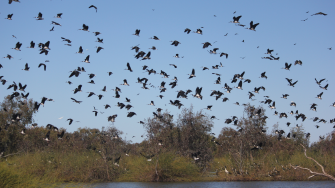
Date: Friday, October 8, 2021
Project: Eastern Australian Waterbird Survey
Observers: Richard Kingsford & John Porter
Pilot: James Barkell
We headed south from Tibooburra, down towards Band 5, which runs from south of Lake Eyre all the way through to the Bellinger River on the coast of NSW. The wetlands just north of Lake Frome are almost always dry. And so we picked up the survey band just east of the Silver City highway between Broken Hill and Tibooburra. Between here and just north of the town of White Cliffs, there are up to a hundred small temporary wetlands which fill from local rainfall. When they are full, they are excellent habitat for waterbirds but today nearly all were dry. The only ones with water were those fed by artesian bore water which spills over from a collection dam, sometimes filling a nearby wetland. The water is high in mineral salts and is often clear and there are nearly always a few pied stilts and red-necked avocets.
After this, we surveyed a few small farm dams. These very seldom have any waterbirds on them and today was no different. Then it was on to the Paroo River overflow lakes. These lie almost at the bottom of the Paroo River, the last free flowing river in the Murray-Darling Basin. The Paroo River fills a series of these lakes before flowing in really large floods to reach the Darling River. Last year there was a reasonably large flooded area here with all the lakes with water as well as the adjoining floodplain. But there wasn’t enough water to get through to the Darling River. There were tens of thousands of waterbirds, particularly on the adjoining floodplain areas. This year only the large lakes and a small patch of floodplain was inundated. We started by surveying Peery Lake which is part of the Paroo-Darling National Park, a wetland of international importance under the Ramsar Convention.
Peery Lake
Unlike last year on Peery Lake when it was reasonably full, this year it had many more waterbirds. This was because it was very shallow, allowing thousands of pink-eared ducks to feed on the small invertebrates that this specialist waterbird depends on. There were also grey teal, a few freckled duck and the odd swan.
Not all of the lakes had water; Poloko and Gilpoko were dry but Yantabangee Lake, Mullawoolka Basin and Tongo Lake were full. We surveyed both these large lakes but there were relatively few waterbirds just a few black duck, pink-eared duck and grey teal, probably only totalling in the hundreds. There were also a few flocks of pelicans. There was an area of flooded channel country south of Mullawoolka Basin, similar to large areas last year. It was clearly very productive, with hundreds of glossy Ibis and Pacific herons as well as grey teal in and out of the flooded areas which reflected a wonderful mosaic of different colours.
Paroo Overflow Lakes
We then surveyed Blue Lake and Green Lake, south of the large lakes. Green Lake had up to a thousand waterbirds, including grey teal and pink-eared duck, as well as many Pacific black duck. It had many waterbirds despite its small size, compared to the large lakes. It was obviously drying back quickly which is when a lot of these lakes come into their own for waterbirds because so much of the area is a feeding ground with invertebrates, frogs and fish in easy reach of the thousands of waterbird bills. After this, we headed east and picked up only one or two more lakes, freshwater and salty, with some water but not many waterbirds and nothing like the amount of water here last year.
We then flew east to the Darling River to survey a billabong on the floodplain which always seems to have water, far from the river. This was very productive with clear water and aquatic vegetation supporting up to a hundred waterbirds. From here we headed east to pick up the Darling River around the town of Louth.
Surveying the Darling River around Louth
And then we worked our way northeast along the Darling River, which had a reasonable flow, but way short of the top of the banks where it can overflow onto its expansive floodplain and fill its billabongs. I wonder if we will ever see one of these floods again with so much water now diverted from this river during medium to large floods on its tributaries. We eventually reached Bourke, after survey run. Our plans to go further and do another leg up of survey up to the Currawinya Lakes had to be postponed until tomorrow. We just didn’t have enough time to refuel the plane and fit in our mandatory Covid test in Bourke at the oval. That’s another challenge in this Covid year while we're travelling across NSW.
By Richard Kingsford
